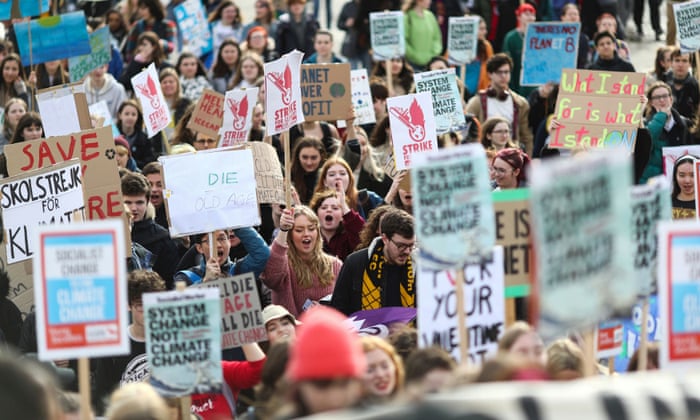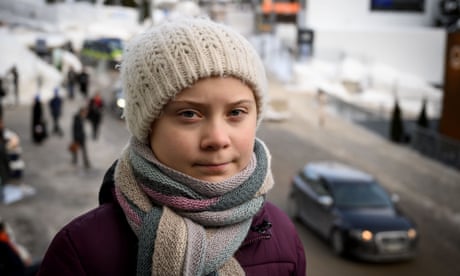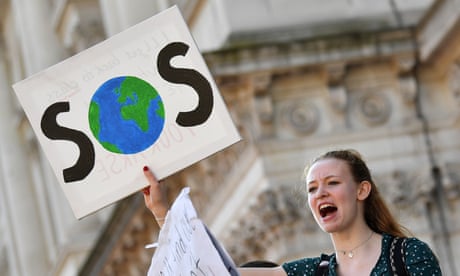In UK, students march on first anniversary of nationwide protests by young people
Greta Thunberg hails school climate strikes
Jonathan Watts and Jessica Murray Fri 14 Feb 2020

Students take part in Friday’s climate strike in London. There were similar protests in other UK cities as well as across the world. Photograph: Simon Dawson/Reuters
Striking students have joined Valentine’s Day rallies across the world as the protest movement attempts to ratchet up pressure on governments and companies before crunch UN climate talks in Glasgow later this year.
Striking students have joined Valentine’s Day rallies across the world as the protest movement attempts to ratchet up pressure on governments and companies before crunch UN climate talks in Glasgow later this year.
In London, the young demonstrators held banners proclaiming “Roses are red, violets are blue, our Earth is burning and soon we will too” and “Climate change is worse than homework” as they marched through Parliament Square on Friday to mark the first anniversary of nationwide climate strikes in the UK.
Students in Durham, Glasgow, Brighton and dozens of other cities also braved often wet and cold condition to march through the streets chanting, “What do we want? Climate justice. When do we want it? Now.”
Greta Thunberg, who initiated the movement as a solitary striker in Stockholm in August 2018, said climate strikes were planned in 2,000 cities across the world on Friday, and that bigger actions were planned for the coming months.
In many countries, the protests have expanded to include local environmental concerns, new strategies and stronger emphasis on global climate justice.
In India on Friday, strikers turned their focus on government plans to deforest swathes of the Aravallis mountain range, which is a conservation area that provides freshwater and oxygen for Delhi and other cities. Some carried banners in English reading: “I love Aravallis”, “Our green lungs” and “Protectors are turning destroyers”.

Teenage activist takes School Strikes 4 Climate Action to Davos
In Sydney, climate strikers demonstrated with banners that depicted the devastating bushfires and blamed the government of Scott Morrison for the “climate chaos” that has hit Australia. In the Philippines, climate strikers organised an educational storytelling campaign to raise public awareness.
In Scotland, Holly Gillibrand, who was one of the first strikers in the UK when she started a vigil outside Lochaber high school in Fort William in the Highlands, said the growth of the movement had been incredible.
“When I began striking over a year ago, Greta Thunberg and Fridays for Future [campaign] were not well known at all and I was one of very few strikers in the UK, but since then, everything has changed. The movement has gone from one person to 7.5 million.
“Even if we still aren’t getting the radical action we need from governments, politicians are feeling the pressure to act and we just need to keep pushing, keep shouting, keep rebelling until they do.” Holly continued her strike on Friday, with a hot chocolate to help get her through the wet weather.
Among those striking for the first time on Friday was a group in Rwanda, where protesters tweeted Timages of themselves holding signs that said: “Rwanda stand for climate.”
Friday’s action was not intended as a mega-strike like those in September, when more than 6 million people took part, but it showed how the campaign has evolved.
Maryam Grassly, 17, who was among the hundreds of strikers in central London, said: “The most enthusiastic and passionate people have stayed on, and more people have got involved and been inspired by it, but at the same time we’ve lost the people who didn’t really care.”
But in her mind there was no question about the relevance of the protest. “When the election happened and Boris [Johnson] got voted in I just kind of gave up on the world, I thought that’s it,” she said. “We’ve got the climate emergency and net zero by 2050 but nothing is happening as fast as it should be.” Similarly she was “excited but worried” about the UK hosting Cop26 later this year, saying the previous conference of the parties in Madrid did not go well.
But the protesters were still hopeful about the difference they have made over the past few months.
Maude Brown, 17, said: “I’ve been very concerned about the issue for almost a decade, I was taught about it in year 4, and no one really cared then so I’m happy that everyone is concerned about it now. I think as more politicians from our generation come in we can make a lot of change in the future.”

Most of the strikers were teenagers, but there were some younger children too. Claire Bullivant, from Essex, has been bringing her children Imogen, 12, Max, 9 and Theodore, 5, to the strikes for a few months.
“I just think it’s so important to get them involved and to support them because they’re so aware of what’s happening in the world, and they see it in the news, and we don’t want to sit back and do nothing,” Bullivant said.
While her daughter’s school has been supportive of her decision to take time off for the strikes, her sons’ school has been less so, but Bullivant said the time off was “totally justified”.
“It’s educational, it’s empowering to be part of a community and show that they’re trying to make a difference to the world, I just don’t think you can underestimate experiences like this,” she said.
Asked why she was so keen to get involved, Imogen said: “If we don’t save the Earth there’s not going to be anywhere else for us to live.”
A year ago, the size of the protests in the UK took police by surprise, as thousands defied their teachers to skip school and join the still nascent movement. The students are now backed by longer established environmental organisations, including Global Justice Now, Greenpeace and the Green party. Among those at Friday’s march in London was a trade union climate bloc.
Friends of the Earth are backing the school climate strikers, who it credits for shifting public opinion. There is still a long way to go, but with technology developments and strong policies, the group said there was cause for hope. “Huge change is possible. In 2019, the UK went coal-free for 19 days. That’s the longest break since the 1880s, and something that would have been unthinkable a few decades ago,” it said.
Play Video
2:55 'I want you to panic': 16-year-old issues climate warning at Davos – video
Play Video 1:20 Thousands of UK students strike over climate change – video
2:55 'I want you to panic': 16-year-old issues climate warning at Davos – video
Play Video 1:20 Thousands of UK students strike over climate change – video
No comments:
Post a Comment